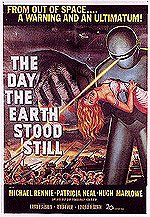
Summary
"Landing in his silvery, domed flying saucer in
Washington, Klaatu (Michael Rennie)--who comes from 250 million miles
away...is wounded by a gun-happy soldier and taken to the hospital.
Recovering quickly thanks to a salve he's brought, he slips away to
try and learn more about humans. Meanwhile, the seven-foot-tall
silver robot Gort (Lock Martin)--who is featureless, save for a visor
that rises to emit a destructive ray--stands guard at the spaceship.
Posing as Mr. Carpenter, Klaatu takes a room at a boarding house and
befriends single mother Helen Benson (Patricia Neal) and her son
Bobby (Billy Gray)....Helen's boyfriend Tom Stevens (Hugh Marlowe)
betrays the alien to the authorities, who corner and shoot
Klaatu--this time to death. Helen rushes to the saucer with
instructions for Gort ("Klaatu barada nikto"). Instead of going on a
rampage, the robot retrieves Klaatu's body, takes it into the saucer,
and brings it back to life long enough for Klaatu to give the
scientists and the world an ultimatum. He tells them that human
violence must not extend into space, that we must join the federation
of planets in peace, or Earth will be reduced to a burned-out
cinder."
(Aliens, Robots and
Spaceships, Jeff Rovin; Facts on File,
Inc.; NY, 1995; p.109-110)
Questions
1. What is the role/function of robot? Why was it created?
Gort is the employee/worker slave of Klaatu, his humanoid master. Gort was created to defend and obey. His brute strength puts him in the role of a soldier.
2. How human is it? How human is it meant to be?
Gort looks human, but has no human emotions. He follows Klaatu's orders. He is not meant to be human since he was created by aliens, although he does have a human form.
3. How does it act in society? How do humans react to it?
The robot Gort is militaristic and does not get along very well in society on Earth. Similarly, the humans perceive Gort as a threat and do not understand that either he or Klaatu could have any other purpose than total conquest of Earth.
4. What are the consequences within the context of the world of the work?
Setting a positive example for robots, Gort and Klaatu teach humans to be on guard against strangers. But, more importantly, Gort shows humans the possible results of their own cowardice and close-mindedness.
5. Does it introduce a new idea or aid in the evolution of the robot? i.e. What's its contribution?
Since the movie was made in 1951, Gort and Klaatu could be seen as comments on the mechanical bi-products of totalitarian regimes. However, a glitch in this theory is that Gort and Klaatu actually moralize humanity at the end of the film. Curiously, the film promotes open-mindedness and peace, warning Earthlings of the dangers of nuclear holocaust. In the Atomic Age of the 1950s, "The Day the Earth Stood Still" sits amongst a stream of alien hate movies that condone democratic isolationism and American patriotism as a contrast to the evils of communism that at the time lay behind the Iron Curtain. Finally, the fact that the screenwriters chose to reverse the power relationship between Gort and Klaatu from what was in the original novel is significant. This change seems to reveal a human anxiety of being conquered and defeated--and as it is expressed in art and media like film, this fear seems much easier to deal with if the threat arises from some external force, like technology or foreign powers.